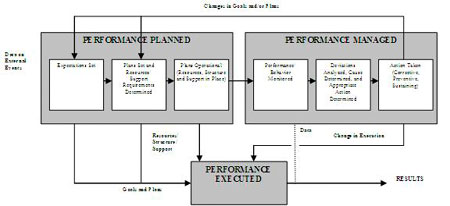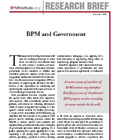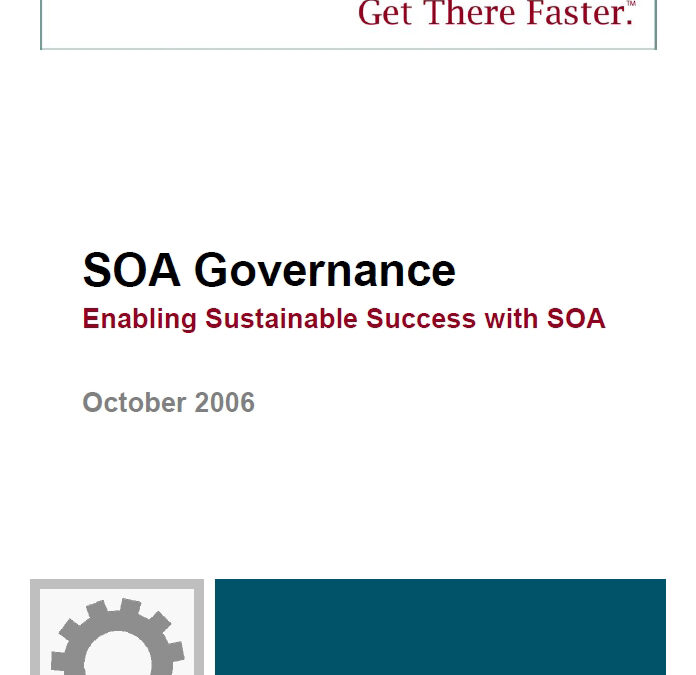Home / Resources
Resources
Discover a Wealth of BPM Knowledge and Expertise at BPMInstitute.org!
Integrating Business Process Management with Public Sector IT Management
John Wilson is an IT Specialist and Project Manager at the Nuclear Regulatory Commission (NRC). His previous federal government experience included management positions at the Smithsonian Institution and the National Institutes of Health.
Wilson pointed out that the federal sector spends a considerable amount of money on IT. For fiscal year 2005 they spent $65B and in 2006 they expect to spend over $200B.
John Wilson is an IT Specialist and Project Manager at the Nuclear Regulatory Commission (NRC). His previous federal government experience included management positions at the Smithsonian Institution and the National Institutes of Health.
Wilson pointed out that the federal sector spends a considerable amount of money on IT. For fiscal year 2005 they spent $65B and in 2006 they expect to spend over $200B. That is a lot of money and it underscores the strong need for business process management in the public sector.

Where Have All the Leaders Gone? The Long-Lost Executive Process Improvement Project
Look at any book on business process management or improvement these days and you’ll see a good amount of advice being expended on the creating, chartering, nurturing and managing of process design, or improvement, teams. Typically, these are made up of employees who perform the processes being improved along with a gaggle of supporters, technical experts, and the like.

The Business Rule Revolution: Is it Real?
“The Business Rule Revolution is the awakening of business leaders to the importance of business integrity and governance through management of individual rules.” A new book, The Business Rule Revolution, is an anthology of real-world business rule experiences shared by the following people: John Zachman, the father of the ZFW for Enterprise Architecture.

What is BPM Anyway? Business Process Management Explained
BPMInstitute.org defines Business Process Management as the definition, improvement and management of a firm’s end-to-end enterprise business processes in order to achieve three outcomes crucial to a performance-based, customer-driven firm: 1) clarity on strategic direction, 2) alignment of the firm’s resources, and 3) increased discipline in daily operations.
BPM is an enterprise-wide, structured approach to providing the products and services that your customer’s value most. It is grounded in the premise that you must take a process view of your company in order to understand what products and services your customer values most. By understanding the key business processes your company uses to meet these customer needs, the gap between customer expectations and your ability to perform begins to emerge.

Golfers Should be Adept at BPM
Amateur golfers know how hard it is to get a consistent, repeatable, powerful golf swing. In golf, as in BPM, there’s no shortage of advice. Many experts agree that the essence of a consistent, repeatable, powerful golf swing has much to do with weight transfer, shoulder turn, swinging on plane, follow through, and balance. The same principles apply to BPM. So let’s explore why golfers should be adept at BPM.
Value of Business Rules – What Does it Mean to Your Organization?
In the series so far, we have seen the basic principles of business rules, roles and responsibilities of a Business Analyst (BA) and Business Rules Analyst. In this article we shall focus on the rationale of this study. What value do business rules bring to your organization? Why are organizations spending time, resources and money in understanding and implementing this ideology? How far does one go and where does one stop? Let us find out answers for these questions that bother an analyst through out the project life cycle.
Business rules are an inherent part of any process.

BPMS Watch: Step Up to “Full” BPMN
When you get started in BPM, the first step invariably is documenting your current, or as-is, process. You can gather the facts from process participants and process owners in a variety of ways – in a group, putting yellow stickies on the wall, or in separate interviews. But eventually you face the challenge of reducing that collected knowledge into a structured, semantically precise yet intuitively understandable, diagram – a process model.
The majority of process “models” in the wild are simply Visio diagrams, applying shapes and lines as the individual modeler sees fit.
Making Sense of SOA Standards Activities – Part I
I’ve seen a lot of activity in the past few months around SOA standards. There’s a joke that goes: “The great thing about standards is that there are so many to choose from”. So let’s review some of the recent SOA activity.
- August – Open SOA Collaboration group is formed to advance work on SCA and SDO
- October – OASIS Reference Model for SOA approved
- December – OMG begins work on UML Profile and Metamodel for Services
So what’s an architect to do?

Research Brief: BPM and Government
This Research Brief highlights a selection of the findings from BPMInstitute.org’s State of BPMSM survey. It reviews the challenges associated with automating government processes such as correspondence tracking, case management, project management and permit applications that involve integration with a variety of information systems. Many government business transformation initiatives involve replacing a manual, paper-based process with an automated, electronic document-based one.

Another Look at Quality
Introduction: Seldom a hot topic now, quality was the holy grail for business fifteen to twenty years ago. At the time, the automotive industry was learning the hard way from Japan that buyers could recognize quality and appreciate it enough to make it a priority in choice-making. The lesson was largely framed through the lens of manufacturing and the concepts of quality control developed by Edwards Demming – a prophet embraced by the Japanese, ignored in America and, suddenly, as important at home as he was abroad.

Why you need an Enterprise Policy Hub
There are two main ways to apply a business rules management system (BRMS). The first is to consider a business rules approach as a way to gain developer productivity, for initial development, but even more for subsequent maintenance. Such productivity gains have proven to be significant – up to 75 percent reduction in ongoing maintenance. The second way to apply a BRMS is to focus on decisioning as a new and emerging class of business problem, and on a BRMS as a platform for automating and improving critical operational decisions.

Business Activity Monitoring (BAM): The New Face of BPM
Business Activity Monitoring (BAM) broke onto the scene three or four years ago, stimulated by the growing interest in Business Process Management (BPM), which made it possible to understand more clearly the relationship between real-time IT operations and business activities. Global 2000 companies, among others, have achieved significant return on investment (ROI) by using BAM as a real-time, intervention-focused tool for measuring and managing business processes.

Change and Innovation in Service Oriented Enterprises
We are at an exciting crossroad bringing technology and business together, as never before. Global collaboration and emerging corporate cultures are creating a new type of innovative enterprise: one that is based on services. Service orientation is about culture, a new service-focused approach of doing business as the modus operandi. Service orientation is also about technology, a standard and effective way of connecting businesses. Enterprises can be empowered to live up to the potential of becoming dynamic, agile, and real-time.

SOA Governance: Enabling Sustainable Success with SOA
Many companies are still in the early stages of SOA adoption and so the practice of SOA governance – and likely the concept itself – will be new territory for many IT professionals. And yet, if companies are to realize any meaningful and lasting impact from SOA, then governance is a fact of life that enterprises are going to have to become comfortable with. More than any other factor over the long term, governance will make the difference between SOA success and failure, and proficiency in governing the SOA environment will distinguish IT leaders from laggards.

SOA Requires a Disciplined Multi-Dimensional Approach
Bhaskar Chakrabarti, principal IT architect at JPMorgan Chase, addresses both tactical and strategic issues in the IT architecture in the financial services giant’s Treasury Services unit. In the tactical area, his group manages specific solutions and application architectural decisions.
Structuring BPM: Business Process Design or Evolution Technologies?
The buzz about business processes, how they should be designed and how employees should use them, is getting louder and more varied. Some vendors are striving to make business process design, implementation and improvement much easier. BEA, IBM WebSphere, Sun SeeBeyond, webMethods, and others are packaging comprehensive infrastructure solutions empowering business analysts as the designers and owners of business process.

Case Study: Applying Process Design Principles
Dan Madison is a principal in Value Creation Partners. He facilitates process improvement using lean, six sigma, reengineering, and continuous improvement techniques. Dan is the author of Process Mapping, Process Improvement, and Process Management.
Dan Madison has studied what a business process should look like for fifteen years. He studied what major corporations did in process improvement that made them successful and distilled his findings into design principles that anyone can use. He has come up with 38 design principles that apply to all business processes.
Dan Madison is a principal in Value Creation Partners. He facilitates process improvement using lean, six sigma, reengineering, and continuous improvement techniques. Dan is the author of Process Mapping, Process Improvement, and Process Management.

Applied Creativity and Value Discipline: The Innovation Cycle – Part 2
Part 2: A manager’s guide for application and implementation of the Innovation Cycle
Innovation is currently a hot topic in the executive suite and in business publications. Amid the buzz, managers are uncertain about how to reconcile the seemingly opposing calls for increased innovation and bottom-line productivity. As a result, when challenged to grow their businesses they often default to more familiar options, even if growth through innovation could be the best choice. We propose not only a truce between the creative and analytic sides of business, but also a highly valuable method for collaboration that builds upon the strengths of each to maximize the value of innovation investments.
Accelerating Innovation & Growth through Open BPM with SOA
Open BPM assumes there are no boundaries in creating, adopting, and improving innovative business processes. With an Open BPM strategy, business processes can now be designed and executed with more flexibility, using standards and best-of-breed functionality to deliver a tailored end-to-end process that is more closely aligned with corporate objectives. A successful Open BPM initiative supports the Business Process Lifecycle.

Creating a Customer Focused – Process Enabled Enterprise By Applying Business Process Management and Six Sigma Together
Creating a Customer focused – Process Enabled Enterprise requires a business process framework, established enterprise architecture, creating “real-time” business intelligence, and a link between continuous improvement projects and key business processes. Most businesses need to evolve from a bottoms-up Six Sigma (DMAIC) approach, to a strategic framework that will set the foundation for growth, accountability, and performance management.













